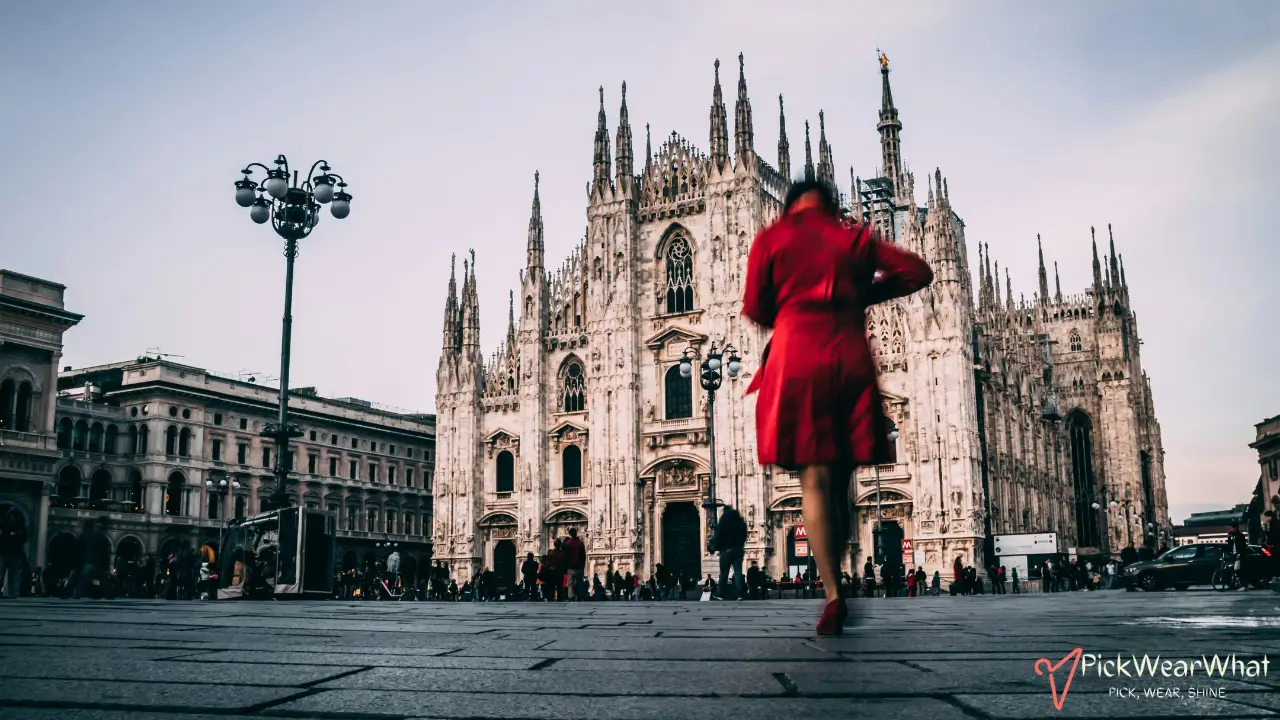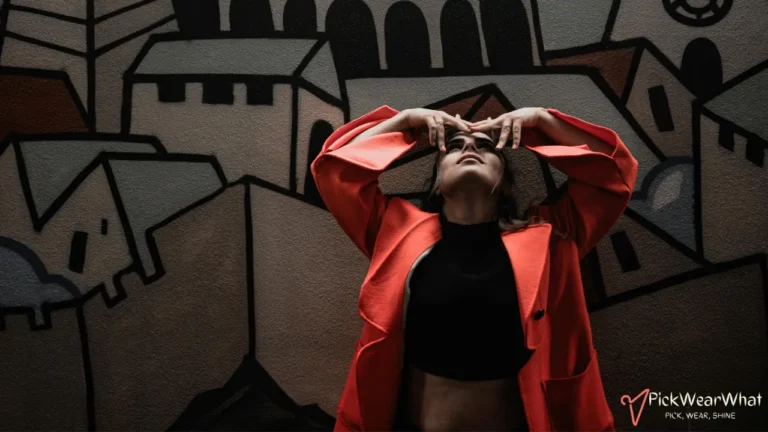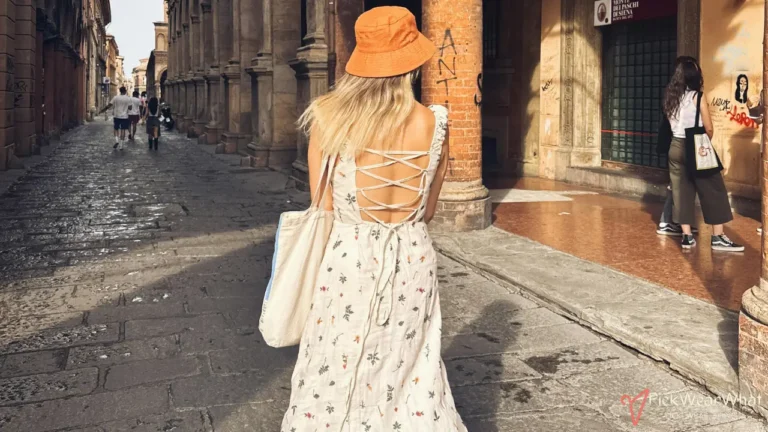In 2025, looking effortlessly stylish in Milan means pairing weather-savvy layers with the city’s famously polished aesthetic—think classic silhouettes upgraded with breathable fabrics, adaptable footwear, and accessories that move easily from cobblestone streets to aperitivo hour.
Milan’s fashion personality walks a tightrope between pragmatic northern-Italian restraint and avant-garde experimentation. Temperatures can swing from damp winter chills to sultry midsummer heat, yet locals maintain an air of understated elegance year-round. The key is planning outfits that respect both the climate and the city’s design-minded sensibilities, allowing you to blend in rather than feel like an obvious visitor.
What To Wear in Milan by Month from Jan to Dec
Whether arriving for men’s fashion week in January or aperitivi al fresco in June, month-specific packing can safeguard comfort and style. Climate data shows winter lows hovering around 0 °C (32 °F), with peak summer highs reaching 32 °C (90 °F) alongside bursts of humidity and the odd thunderstorm.
Meanwhile, shoulder seasons test layering chops with crisp mornings that mellow into sunlit afternoons. The table below condenses each month’s typical conditions alongside outfit ideas for men and women, spotlighting fabric choices, must-have outerwear, and shoe suggestions that pass both comfort and sartorial tests.
| Month | Avg. High / Low | Key Weather Notes | Men – Essential Pieces | Women – Essential Pieces |
|---|---|---|---|---|
| January | 6 °C / -1 °C | Cold, damp; occasional snow flurries | Wool overcoat, cashmere roll-neck, thermal undershirt, Chelsea boots, merino beanie | Long wool coat, cashmere sweater-dress, fleece-lined tights, leather ankle boots, blanket scarf |
| February | 8 °C / 0 °C | Similar chill, brighter skies late month | Quilted parka, brushed-cotton shirt, fine-wool trousers, leather gloves | Belted wool-blend coat, silk-blend turtleneck, straight-leg jeans, water-resistant boots |
| March | 13 °C / 4 °C | Early spring showers, chilly evenings | Unstructured blazer, merino cardigan, chinos, suede desert boots | Trench coat, light cashmere crewneck, midi skirt, loafers |
| April | 17 °C / 8 °C | Unpredictable rain, pollen season | Rain-proof field jacket, Oxford shirt, lightweight knit, waterproof sneakers | Waterproof trench, Breton top, culottes, low-top sneakers |
| May | 22 °C / 13 °C | Pleasant warmth, longer daylight | Linen-blend blazer, short-sleeve knit polo, tailored shorts (for escapes outside city center), loafers | Linen blazer, sleeveless silk blouse, cropped trousers, espadrilles |
| June | 27 °C / 17 °C | Humidity climbs, alfresco nights | Cotton seersucker shirt, breathable chinos, woven belt, leather sandals (evening swap to loafers) | Sleeveless linen dress, straw hat, leather sandals, lightweight shawl for breezy nights |
| July | 30 °C / 19 °C | Hottest, occasional thunderstorms | Moisture-wicking tee, linen shorts, open-weave loafers, foldable umbrella | Flowy midi dress in cotton voile, breathable flats, cross-body bag, anti-humidity hair accessories |
| August | 29 °C / 19 °C | Ferragosto closures, muggy heat | Collarless linen shirt, cuffed chinos, slip-on sneakers, UV-blocking sunglasses | Lightweight jumpsuit, raffia bag, strappy sandals, silk scarf (doubles as hair tie) |
| September | 24 °C / 15 °C | Fashion Week bustle, mild warmth | Lightweight blazer, poplin shirt, dark denim, brogues | Tailored blazer, satin cami, wide-leg trousers, slingback heels |
| October | 18 °C / 10 °C | Crisp air, golden foliage | Waxed-cotton jacket, merino crewneck, twill chinos, leather boots | Camel trench, ribbed knit top, A-line skirt with tights, ankle boots |
| November | 11 °C / 5 °C | Foggy mornings, drizzly afternoons | Wool-blend peacoat, flannel shirt, thermal tee, waterproof boots | Wool wrap coat, cashmere cardigan, corduroy pants, waterproof ankle boots |
| December | 7 °C / 0 °C | Festive markets, possible snow | Double-breasted overcoat, brushed-wool scarf, lambswool jumper, insulated Chelsea boots | Faux-fur-trim coat, velvet dress layered over heat-tech top, thermal leggings, knee-high boots |
What To Wear in Milan by Season
Seasonal strategy streamlines packing when travel dates span multiple months. Milan follows classic temperate-continental rhythms—cold winters, steamy summers, and transitional spring and autumn intervals—yet micro-climates within the Po Valley can intensify humidity and trap fog.
By understanding broad seasonal patterns, visitors can assemble capsule wardrobes that pivot gracefully between morning cappuccinos and late-night gelato runs without overstuffing luggage.
| Season | Typical Range | Style Priorities | Men – Go-To Looks | Women – Go-To Looks |
|---|---|---|---|---|
| Winter (Dec–Feb) | -1 °C to 8 °C; damp chill | Thermal layering, wind protection, refined outerwear | Tailored wool overcoat, cashmere scarf, thermal undershirt, lug-sole boots | Belted wool coat, heat-tech tights, chunky knit scarf, water-resistant boots |
| Spring (Mar–May) | 4 °C to 22 °C; rain bursts | Light layers, waterproof shells, breathable knits | Cotton trench, merino cardigan, chinos, suede loafers | Classic trench, silk blouse, cropped pants, loafers |
| Summer (Jun–Aug) | 17 °C to 32 °C; humid | UV protection, airy fabrics, sweat-friendly footwear | Linen camp-collar shirt, pleated shorts, woven loafers | Linen sundress, straw panama hat, leather sandals |
| Autumn (Sep–Nov) | 5 °C to 24 °C; crisp & foggy | Smart layering, mid-weight coats, deeper palettes | Waxed jacket, lightweight sweater, dark denim, brogues | Camel trench, rib-knit sweater, midi skirt, ankle boots |
Packing Tips for Milan’s Stylish Streets
Walking through Brera’s art-lined lanes or crossing Piazza del Duomo requires clothing that stands up to cobblestones, unpredictable rain, and a style bar set famously high. Streamlined packing starts with neutral color palettes—charcoal, navy, ecru, and camel—that mix effortlessly and leave space for statement accessories.
Materials matter: natural fibers like merino, linen, and cotton breathe well and resist odors, while newer performance blends add stretch for bike-share rides along Navigli. Rolling garments instead of folding reduces wrinkles and maximizes luggage real estate, ensuring there is room to tuck in a fresh piece picked up during a Via Montenapoleone shopping spree.
Why Layering Matters in Transitional Months?
Early spring and late autumn in Milan can feel like a seasonal tug-of-war, with icy dawn air giving way to sunny café patios by lunch. Layering provides insurance against these swings and saves money on taxi hops back to the hotel. Start with a moisture-wicking base that keeps perspiration under control should the afternoon warm up.
Add a lightweight knit—merino or fine-gauge cotton—and finish with a water-resistant jacket that stows easily in a day bag when temperatures climb. Men often favor unstructured blazers or field jackets, while women gravitate toward belted trenches or cropped bouclé jackets that add texture without excess bulk.
Which Fabrics Handle Milan’s Summer Humidity Best?
High-humidity days can make synthetic fabrics feel like plastic wrap. Linen remains the hero thanks to its open weave and rapid-drying properties, yet many modern travelers worry about wrinkles. A linen-cotton blend delivers the same airflow with fewer creases, while Tencel and bamboo viscose offer silky drape and eco credentials. Men can swap standard cotton tees for linen-jersey or Tencel polos. Women may choose cupro slip dresses that glide over the body, allowing breeze circulation beneath a light cardigan when entering air-conditioned museums.
Footwear Choices That Balance Comfort and Elegance
Cobblestones are unforgiving; even luxury heels can wobble in the gaps between Sanpietrini stones near Porta Ticinese. Blending fashion and function starts with shock-absorbing insoles and sturdy soles. Men often rely on leather-lined loafers or minimalist sneakers with supportive footbeds, switching to ankle boots in cooler months.
Women navigate the terrain in block-heel pumps, lug-sole loafers, or chic sneakers from Italian heritage brands that pair seamlessly with dresses and trousers alike. Break shoes in before travel to avoid resorting to unfashionable tourist sandals mid-trip.
How to Choose All-Weather Shoes for Milan?
Rain can pop up suddenly, and puddles collect where ancient paving sinks. Water-resistant leather or coated canvas keeps feet dry without resorting to bulky rain boots. Look for stitched—not glued—soles and consider natural rubber outsoles for superior grip. A quick-drying spray adds extra protection, and packing ultra-thin Merino socks ensures moisture wicks away if showers catch you off guard.
Accessories Locals Swear By
Italian style prizes subtlety in color but boldness in detail. A silk scarf hand-painted in Como adds a splash of personality, while tortoiseshell sunglasses protect against sharp sun angles reflecting off marble façades. For men, a knitted tie turns a simple linen shirt into aperitivo-ready attire, and a leather-trimmed tote carries laptops or market finds.
Women often cinch dresses with slender belts and top ensembles with statement earrings that glint beneath evening terrace lights. Pack a compact umbrella; Milan’s weather apps are notorious for optimistic forecasts.
What Tech-Savvy Accessories Improve City Exploration?
Power banks slim enough for a cross-body clutch keep translation apps and digital tickets alive. RFID-blocking cardholders deter pickpockets in crowded metro stations, while foldable reusable totes handle impromptu purchases at vintage markets like East Market Milano. Noise-canceling earbuds soften tram rattles yet keep one ear free for charming street performers on Via Dante.
Dressing Etiquette for Cultural Hotspots
Milan’s churches, such as the grandiose Duomo di Milano or Santa Maria delle Grazie housing Da Vinci’s Last Supper, enforce modesty rules—shoulders covered and hemlines near the knee.
Lightweight shawls for women and unbuttoned overshirts for men provide quick compliance without compromising style elsewhere. Upscale restaurants on Corso Venezia may require jackets, especially after 7 pm. A packable sport coat or a refined wrap dress transitions seamlessly, avoiding last-minute wardrobe scrambles.
How Formal Is Milan’s Evening Scene?
While Apericena—aperitif-meets-dinner buffets—can be relaxed, true fine-dining spots expect smart-casual at minimum. Men should opt for collared shirts and leather shoes; pristine sneakers, though increasingly accepted, can still raise brows in Michelin-starred locales.
Women succeed with tailored jumpsuits or midi dresses paired with low heels. In warmer months, open-toe shoes are acceptable if impeccable pedicures accompany them.
Essential Fabrics and Layering Strategies
Selecting fabrics aligned with season and activity minimizes over-packing and maximizes comfort. Natural fibers regulate body temperature more effectively than synthetics; however, innovative blends have narrowed the performance gap.
Which Layer Goes Where?
A foundation of breathable base layers—merino tees or silk camisoles—wicks moisture from the skin. Mid-layers provide insulation: lightweight cashmere in winter, cotton cardigans in spring. Outer layers serve as weather shields—think waxed cotton or technical shell jackets.
The “three-layer rule” adapts to both winter chills and air-conditioned summer interiors and reduces the need for cumbersome single heavy garments.
Frequently Asked Questions About Dressing for Milan
The following concise answers resolve the most common wardrobe dilemmas voiced by visitors planning a trip.
Do Locals Wear Shorts in the City Center?
Milanese men rarely wear shorts outside parks or casual weekend outings. Tailored chino shorts are acceptable for men in suburban areas but frowned upon in luxury shopping districts. Women’s tailored Bermuda shorts or linen culottes pass muster when styled with polished tops and leather sandals; athletic shorts remain best left for jogging routes along Parco Sempione.
Is It Acceptable to Wear Sneakers to Dinner?
Minimalist leather or high-quality suede sneakers in pristine condition are welcome in casual trattorias and many modern bistros. However, brightly branded running shoes clash with the city’s refined evening mood and may result in denied entry at upscale establishments. Err on the side of elegance by choosing low-profile designs and pairing them with smart separates.
How Can I Pack Light Yet Be Ready for Every Occasion?
Create a capsule of interchangeable neutrals: two tops for every bottom, one versatile dress or blazer, and accessories that shift outfits from day to night. Rely on fabrics that resist wrinkles and odors—merino, linen-blends, and technical cottons—and plan to launder mid-trip. Rolling items saves space, while packing cubes maintain order.
What Should I Wear for Day Trips to Lake Como or Bergamo?
Day trips often involve micro-climate shifts—warmer lakeside breezes versus cooler hilltop winds. Layering remains vital: bring a soft shell or cardigan, comfortable walking shoes with grip for cobbled historic cores, and polarized sunglasses to cut lake glare. Women may choose floaty dresses paired with denim jackets, while men can rely on linen shirts layered under lightweight vests.
Are Umbrellas or Rain Jackets More Practical?
Compact umbrellas suit city strolling, especially amid narrow arcades, but gusty spring storms can flip flimsy models. A packable waterproof shell offers hands-free convenience when shopping or carrying gelato. Many travelers carry both: a slim auto-fold umbrella and a featherweight rain jacket that doubles as a windbreaker during shoulder seasons.
Key Takeaways for a Seamless Milan Wardrobe
Understanding local style codes and meteorological nuances ensures clothing choices feel organic rather than contrived. Lean on quality over quantity, prioritize breathable natural fabrics, and build ensembles around adaptable layers.
Footwear should conquer cobblestones without sacrificing flair, and accessories—silk scarves, structured totes, classic sunglasses—elevate even the simplest base outfit. By following these principles, travelers step confidently into Milan’s cafés, galleries, and fashion events, blending comfort with the effortless elegance the city is renowned for.




